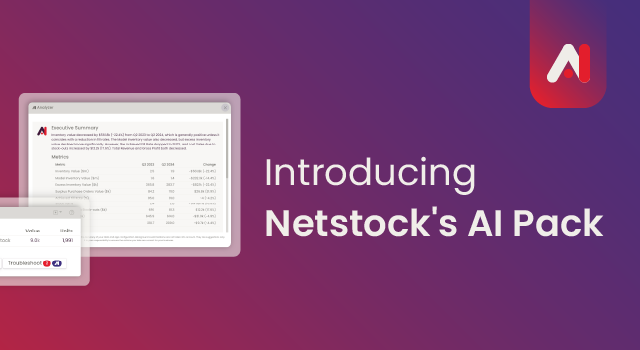Inventory management, in its current form, has come a long way since it was managed on ledgers and Kardex. Still, inventory management is once again on the cusp of new developments. Machine learning and Artificial Intelligence hold the promise of a whole new era for inventory management.
Let’s explore recent changes.
The evolution of inventory management
The introduction of computers and inventory management software in the 1980s completely changed the way businesses managed their stock. It was no longer necessary to keep exhaustive handwritten ledgers and place manual orders. Bills of Material and Material Requirements Planning systems revolutionized the workplace. Modern computer software enabled repetitive task automation, reducing errors and improving stock accuracy.
With the introduction of automation, it reduced errors and freed staff to do more valuable work. Accurate, real-time data drove better decisions. Now, organizations could turn their attention to stock reduction strategies.
The introduction of Enterprise Resource Planning (ERP) ensured that people worldwide used the same terms and adhered to the same inventory management principles. Just-in-time delivery became a feature in many modern production facilities. Integrated financial management systems streamlined processes and enhanced transparency.
With Artificial Intelligence(AI), inventory management has taken another step into the future. Today, AI-enabled software allows businesses to deliver improved customer service with less inventory. It uses sales data and other inputs to identify patterns and predict future demand. AI can produce more accurate forecasts than previously possible.
A more recent development, cloud-based storage, has enabled enterprise data over the web. Now, users can access product data from across the globe at any time.
AI enables proactive management
AI functionality is set to propel Inventory Management technology to new heights. Although artificial intelligence has been around for decades, its general use in everyday activities is a recent development. AI software for inventory management analyses vast amounts of data by leveraging sophisticated algorithms. This enables accurate demand forecasting, which can reduce the need for safety stocks.
There is no longer a need for fixed reorder points. AI-infused software can predict demand fluctuations and adjust order quantities in real time. With AI, businesses shouldn’t be caught with excess stock or run out of the stock they need to fill orders. Using supply and demand solutions, that’s powered by AI can even predict obsolescence so that you can take action to reduce the impact and get rid of the stock before it becomes a problem.
With AI, you can reduce your stockholding and the associated costs of storage, insurance, and more. This will free up working capital to grow your business rather than tying it up in inventory.
AI’s role in demand forecasting
AI analyzes vast amounts of data from across a wide spectrum of sources. It identifies complex patterns and can uncover relationships between factors that influence demand. For example, consider how promoting one product can impact the sales of another. Additional factors that could influence this dynamic include weather conditions and social media activity.
Without the power of AI, these relationships might never come to light, and organizations would miss the chance to improve profitability. AI is not static. It continually adapts and forecasts in sync with consumer behavior and market changes, helping you stay one step ahead of the competition. It could become your competitive advantage.
The AI advantage
AI functionality helps businesses eliminate reactive inventory systems. Organizations can now adopt a more proactive stance, anticipating customer needs. More accurate demand forecasts help minimize stock holding costs without risking stock-outs. With AI functionality, managers can effectively allocate resources across sales channels and locations. Marketers can also develop targeted campaigns based on predicted demand.
Real-time inventory tracking and management
AI easily integrates with automated inventory management systems in the following ways:
Automatic reordering
Managers have previously set reorder points manually. Artificial Intelligence in inventory management enables dynamic demand forecasting. The system triggers orders when inventory drops below the calculated limit.
Dynamic safety stock
AI functionality in software uses factors like supplier lead times and demand changes to adjust and optimize safety stocks. It ensures you have enough buffer stock to handle unexpected demand without carrying unnecessary stock when sales are slower.
Inventory for promotions
An inventory management system with AI functionality can automatically allocate stock to warehouses with higher demand. It can predict the impact of promotions and ensure you have stock in place on time.
Dynamic production planning
AI technology is particularly useful in manufacturing plants. The system can anticipate demand and adjust production plans to meet the demand. Dynamic planning ensures finished goods availability without drawing surplus materials into the system.
Automated warehouse replenishment
AI can analyze stock levels across many warehouses. Then, automatically trigger transfers to maintain ideal stock levels throughout the network.
Enhancing customer experience with AI
AI functionality monitors inventory in real-time across multiple channels. This ensures stock transparency across the organization, destroying silos and eliminating discrepancies. It forecasts demand through sales history analysis and will factor in seasonal sales and marketing campaigns to ensure you have the stock to meet demand without overstocking.
Automating repetitive tasks using the AI functionality in your inventory system should result in fewer mistakes and faster delivery, taking your customer service to the next level. Excellent customer service translates into happy, loyal customers, who will return to do business again.
AI in automated reordering and supply chain optimization
Leveraging advanced algorithms, AI technology analyzes vast amounts of supplier data to identify the most reliable and cost-effective partners. Use it to consider factors like lead times, production capacity, and past performance.
Dynamic reorder points and automatically generated purchase orders ensure that orders correctly reflect your requirements. Real-time data sharing enables improved planning across the supply chain, leading to a consistent and reliable supply line.
AI functionality can reduce costs and improve operating efficiency as it optimizes shipping routes and warehouse placements. To do this, it analyzes transit times, traffic conditions, delivery windows, and the weather. The result is improved fuel consumption, reduced transport costs, and enhanced delivery performance.
Reducing costs and increasing profitability
Inventory management has always been a balancing act. Organizations must hold enough stock to meet demand without incurring unnecessary storage and shipping costs. With AI inventory management software, you can make significant cost reductions and improve profitability.
Here’s how AI functionality can help:
- Accurate demand forecasting: Analyses vast amounts of data to create better demand forecasts. With the confidence of more accurate forecasts, you can reduce safety and buffer stocks. With less inventory, you need less warehouse space and incur lower holding costs.
- Optimized reordering: Sets dynamic reorder points based on predicted demand and lead times. Stock arrives when it is needed.
- Automated replenishment: Automates the reordering process, eliminating manual errors. Reliable, consistent supply reduces the need for more expensive expedited shipping.
By minimizing storage and shipping costs, inventory optimization, infused with AI functionality, significantly improves financial performance by:
- Increasing profit margins: Lower storage and shipping costs mean higher profit margins.
- Improving cash flow: Reduced inventory releases cash. Use the freed funds elsewhere for projects like product development or market expansion.
- Enhanced agility: With real-time data and less stock, your business can quickly adapt to changing market conditions. Only agile businesses can maintain and improve profitability in today’s fast-changing markets.
Implementing AI in inventory management
Implementing inventory management software, that offers AI functionality, can significantly improve accuracy, decision-making, and operational efficiency. Organizations that fail to adopt AI for inventory management will be left behind as others embrace the technology. Still, successful AI adoption calls for careful planning and implementation.
Nine steps on what you need to do:
- Assess your business needs: Clearly define your inventory management challenges. These may include optimized stock levels, reduced carrying costs, fewer stock-outs, or improved demand forecasting accuracy. All are possible with AI.
- Data requirements: Ensure that all the data is in place to make the best use of AI functionality. You’ll need up-to-date and accurate sales history, product information and supplier data. The data must be clean, consistent, and properly formatted for effective analysis.
- Choose your AI techniques: Chosen techniques might include machine learning for demand forecasting or natural language processing for customer feedback analysis.
- Develop Models: Train machine learning models using historical data. Use AI to predict future demand, detect patterns, and optimize inventory levels. Continuously refine and update these models as new data becomes available.
- Integrate the AI with your existing system: Ensure continuous data flow between systems for real-time decision-making.
- Track and assess performance: Track key metrics like forecast accuracy, inventory turnover, stock-outs, and carrying costs. Experiment with parameters, and data sources for best performance. Identify areas for improvement and adjust.
- Consider scalability: Design your artificial intelligence inventory management system to grow with your business and adapt to changing market conditions. Choose a flexible system that can accommodate new products, channels, and business needs.
- Train staff: Staff must know how to use and interpret AI-generated insights.
- Stay up to date: Know what’s happening in the world of AI for inventory management. Discover new tools and techniques and build a business with a future.
By investing in inventory management solutions that offer AI functionality, you’re guaranteed to make quicker inventory decisions, adjust planning in line with market changes and release valuable working capital to pursue growth objectives.
Optimize your inventory management with Netstock and experience ongoing ROI.




